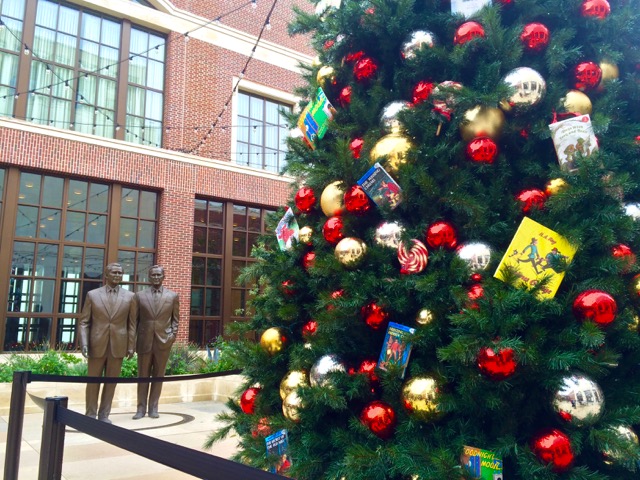 As American stores pulled their employees back into work last night to strip out the old Christmas junk and get up the Valentine’s chocolates, the British and the inhabitants of their remnant Commonwealth are celebrating Boxing Day. Though most agree that the celebration of the day after Christmas began in England in the mid-ninetheeth century, disputes over exactly what the day means continue. Rest assured that the holiday’s name didn’t come from people fighting over the holiday’s name.
As American stores pulled their employees back into work last night to strip out the old Christmas junk and get up the Valentine’s chocolates, the British and the inhabitants of their remnant Commonwealth are celebrating Boxing Day. Though most agree that the celebration of the day after Christmas began in England in the mid-ninetheeth century, disputes over exactly what the day means continue. Rest assured that the holiday’s name didn’t come from people fighting over the holiday’s name.
My thoughts lean toward the story of the aristocracy giving their servants the day off and offering them ‘boxes’ of small presents and leftovers from the Christmas feast those same servants prepped and served (from the left) Christmas Day. But that’s because I’ve a mean streak for aristocracies and find the fawning given to the queen or her grandsons rather nauseating. But let’s leave that fight for another day, and turn to the modern meaning of Boxing Day.
 Football! Although every European league takes a break from the Sunday before Christmas to the end of January (or a bit later), and although every European league produces far more world-class players than the English Premier League (EPL), the cascade of footie that comes our way from across the pond are sheer joy for the fans (Thank you NBC Sports!). English clubs play 3 matches in 10 days, sometimes 4 in a fortnight (Easy mate. It’s the bloody aristos that git me ire. The footie and lager and Spice Girls are first rate!). Boxing Day 1963 still holds the record for the most goals scored in a single day of top-flight English football. And it was mostly done on snow-covered pitches, which players today would whine about.
Football! Although every European league takes a break from the Sunday before Christmas to the end of January (or a bit later), and although every European league produces far more world-class players than the English Premier League (EPL), the cascade of footie that comes our way from across the pond are sheer joy for the fans (Thank you NBC Sports!). English clubs play 3 matches in 10 days, sometimes 4 in a fortnight (Easy mate. It’s the bloody aristos that git me ire. The footie and lager and Spice Girls are first rate!). Boxing Day 1963 still holds the record for the most goals scored in a single day of top-flight English football. And it was mostly done on snow-covered pitches, which players today would whine about.
Today’s matches offered fewer goals (a mere 23 vs. 66 in ’63), but had more surprises: Manchester United continue to tumble down the table like a box of Christmas coal. Chelsea – last year’s champions – still look like a parody of self-important rich kids petulant that the world won’t give them what they want. Aston Villa didn’t simply give up again, having been scored on, and fought back for a draw. Mere Liverpool defeated top-of-the-table Leicester City, which gave Arsenal a chance to go top against Southampton, riding a 6-match losing streak with no goals at all. But the EPL is the gift that keeps on giving, so Southampton lashed Arsenal 4-0.
 The holiday stretch of the EPL marks the mid-way point of the season, the marker that largely augurs the final standings, and the last window through which one can throw risky predictions (if a pundit wants to claim true clairvoyance). When the season ends in mid-May, the top team is, of course, crowned champions, and the bottom three teams being sent down to the lower division for the next year at least. Installing relegation in American sports would create huge fan interest. Consider the possibility (probably best available to baseball) that an Oakland As or a Cincinnati Reds were threatened with relegation! The players would actually try to fight for a few wins in August to keep their multi-millions! And more than a dozen hundred fans might watch. Imagine a Durham Bulls or Toledo Munhens getting a chance to step up in their places, giving a couple dozen fresh faces who might become superstars! Of course, in the land of rampant post-capitalism, the cartel of American professional sports would never allow such meritocratic free enterprise. But if MLS and the NASL agree to join forces to build such a system, I guarantee you the advertising dollars will flow soccer’s way. But – as always – I digress.
The holiday stretch of the EPL marks the mid-way point of the season, the marker that largely augurs the final standings, and the last window through which one can throw risky predictions (if a pundit wants to claim true clairvoyance). When the season ends in mid-May, the top team is, of course, crowned champions, and the bottom three teams being sent down to the lower division for the next year at least. Installing relegation in American sports would create huge fan interest. Consider the possibility (probably best available to baseball) that an Oakland As or a Cincinnati Reds were threatened with relegation! The players would actually try to fight for a few wins in August to keep their multi-millions! And more than a dozen hundred fans might watch. Imagine a Durham Bulls or Toledo Munhens getting a chance to step up in their places, giving a couple dozen fresh faces who might become superstars! Of course, in the land of rampant post-capitalism, the cartel of American professional sports would never allow such meritocratic free enterprise. But if MLS and the NASL agree to join forces to build such a system, I guarantee you the advertising dollars will flow soccer’s way. But – as always – I digress.
For an example of how the league table after Boxing Day pretty much reflects the league table in May when the season ends, only once in the post-WWII era has the team at the bottom of the table at Christmas escaped relegation: Leicester City last year. And only twice in the twentieth century has a team gone from bottom of the table one Boxing Day to top of the table the next Boxing Day: Leicester City this year. Good for them! Few pick them to hang on to win the championship, and I don’t either. They’ll finish second. Third? Alas, they’ll tire in the wet late winter when richer clubs can afford to rest a top player or two and still win. Leicester play some lovely, quick, incisive footie. But they need eight or nine of their best eleven to do it. Arsenal and Man City (Leicester’s closest competitors) aren’t as much fun to watch but they can beat most teams with about 2/3rds of their first-team squad. That staying power will likely give one of them the championship, and I’m pulling for Wenger’s Arsenal, even after today’s shambles. He is a gentleman in and a professor of the game, and if there were poetic and heroic justice in the game, he would retire as manager of the league champions. But there isn’t. Ask Steven Gerard.

(Photo by Clive Brunskill/ Getty Images)
Which leads me to my beloved Liverpool, who just beat the league leaders 1-0 at home today on Boxing Day! Three points that move us up to 8th! The Klopp Effect is back! We’re on our way to a top-four place! (And thus a place in the incredibly lucrative European Champions’ League next year. And no, Virginia, you don’t need to be a champion to be in the Champions’ League.)
Hold on, lads. Liverpool have also beaten Manchester City and Chelsea (Ok, that win doesn’t seem as impressive now at it did in mid-October). Yet they can’t beat any of the teams near them in the table, and they barely earned a draw against relegation-threatened WBA. The Boxing-Day gift of a win against the league leaders needs to be put in the context of the match itself. I fear we’ll find that the sparkly present is only so much cheap tinsel.
First off, Divock Origi, a rare striker in Red who moves both on and off the ball, went off hurt late in the first half. Though his is probably not serious, Anfield Road (Liverpool’s stadium) has become the land where decent strikers go to get ground down by injury. We had to run Michael Owen to death back at the turn of the millennium, and Danny Ings is only the latest on that list – though Daniel Sturridge has now earned the untimely honor of having sat on the bench injured for more matches than he has suited up to play. In what other walk of life besides sport can you get paid millions not to do what you are paid to do? Well, besides being a politician?
Next, Liverpool’s/Klopp’s “gegenpress” continues to look so exciting in the first half-hour of most matches but is so ineffective if we look at the results after 90 minutes. Rarely do the Reds turn such dominance in pace and possession into dominance on the scoresheet. Once Origi had to step off to be replaced by Christian Benteke, the high-pace pressure (a ‘full-court press’ to use a basketball analogy) was guaranteed to slack off. It did, and Leicester started to find their way toward the Liverpool goal. Benteke is such an odd player, and evidence that, alas, previous Liverpool manager Brendan Rodgers really had no idea how to spot a player with reserves of skill. Benteke undid LFC twice last year when he played for soon-to-be-relegated Aston Villa. So Rodgers wanted to buy him, apparently oblivious how the player worked in Villa’s squad but not really offering something for whatever stew Rodgers was trying to cook up.
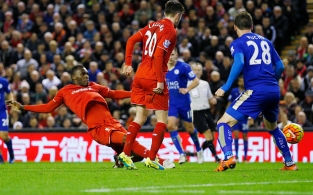
Football Soccer – Liverpool v Leicester City – Barclays Premier League – Anfield – 26/12/15 Christian Benteke scores the first goal for Liverpool Reuters / Phil Noble Livepic EDITORIAL USE ONLY.
That Benteke got the goal that gave LFC the three points will only delay the reckoning that he is a solid striker in a certain team with a certain style, none of which Liverpool seem to be wanting to emulate. It was a nicely taken goal, no doubt. But the beauty and opportunity were created by the Brazilian Roberto Firmino − another player who must have had a good match or two that Mr. Rodgers just happened to see. And what gave Benteke any chance were the two steps he took back from the Leicester defender marking him. But I fear he won’t have learned the lesson, so he will continue to line up in an offsides position and try to run at some long cross that may, or likely won’t, find his high head. The linesperson will flag him anyway.
And finally, the Reds missed two wide open goals on breakaways that saw them with numerical advantage over an ever-spirited Leicester. If you don’t have the clinical confidence to put opportunities like this away (at least fifty percent of the time!), you won’t move much up the table, no matter where you’re sitting on Boxing Day.
To be fair, others missed the goals, but in both cases (87th & 92nd minutes; In the latter instance Leicester keeper Kasper Schmeichel was at the other end of the park having tried to head in a last desperate corner kick!), Benteke made the wrong run − ‘run’ singular because both times he made the same mistake: he ran straight ahead and parallel with his teammate with the ball. Such runs are made by naive players who think they are faster than they are and better than they are. Moreover, such runs hurt the man on the ball as well: he is being closed down in front of goal by opponents because his shadow has not created any space for him, and while that space is not there, he also has no one to pass to.

Is Herr Klopp happy, or is Emre Can about to get a wallop for cheaply losing possession yet again?
And all that seems to summarize Liverpool FC at the half-way mark. Under Klopp, they can play a more spirited and lively game if in the mood, which is certainly fun to watch. But under Klopp their record is really no better than it was in the last months of Brendan Rodger’s tenure. Given the fact that Klopp is working entirely with players Rodgers brought in, it really isn’t a surprise. Nor is it a surprise that pundits smirked at Rodgers’s purchase of a lanky, lumbering striker named Christian Benteke, brought in to replace a lanky, lumbering, and lazy striker named Mario Balotelli, himself bought to replace an off-loaded lanky, lumbering, but lively striker named Andy Carroll − all while management keep talking about this beautiful Barcelona-esque passing game they are brewing. I’d rather have Andy back if these are our choices.
But it’s Boxin’ Day guv-nah! So a tip of me cap to your lordship, and thank ye for the scraps! See you in 7th spot in May, Scousers!
 May you enjoy your holiday with family, friends, delicious foods, and with the embrace of love (both eros and agape) that we all hope for and Christmas represents. But (on the assumption what whoever is reading this is sitting comfortably in a professionally built home in a politically stable country) may I suggest that no present any of us will receive over the next forty-eight hours compares to the one given by
May you enjoy your holiday with family, friends, delicious foods, and with the embrace of love (both eros and agape) that we all hope for and Christmas represents. But (on the assumption what whoever is reading this is sitting comfortably in a professionally built home in a politically stable country) may I suggest that no present any of us will receive over the next forty-eight hours compares to the one given by 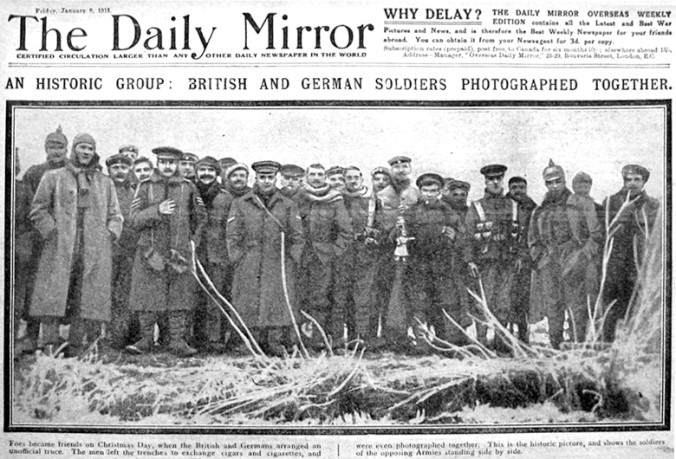 This season, many are marking the hundredth anniversary of the “Christmas Truce” that was observed between especially German and British soldiers for a couple of December days in 1914. Though they sat on opposite sides of muddy fields and across the too many dead, soldiers up and down the front allowed the spirit of the season to soften their many differences and to share a few hours of peace. In a far less dangerous way I stand before you as a conflicted speaker, and I do not want to mask that conflict from you. As a professional historian, I know that the holidays we celebrate at this time of year – Christmas, Hanukkah, and every 15 years or so, Ramadan – are not the holidays celebrated by those religious communities a hundred years ago, much less 500 or 1000 years ago.
This season, many are marking the hundredth anniversary of the “Christmas Truce” that was observed between especially German and British soldiers for a couple of December days in 1914. Though they sat on opposite sides of muddy fields and across the too many dead, soldiers up and down the front allowed the spirit of the season to soften their many differences and to share a few hours of peace. In a far less dangerous way I stand before you as a conflicted speaker, and I do not want to mask that conflict from you. As a professional historian, I know that the holidays we celebrate at this time of year – Christmas, Hanukkah, and every 15 years or so, Ramadan – are not the holidays celebrated by those religious communities a hundred years ago, much less 500 or 1000 years ago.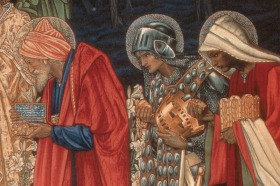 For me, one of the most touching – and contemporarily significant – reconciliations of tradition involves the story of the Three Kings. Matthew’s Gospel in the Bible speaks famously of an unnamed number Magi “from the east” bearing three gifts for the Christ Child. Quite soon the number of gifts was passed onto the number of priests, whose origins would have been from Persia or India. Nevertheless, a tradition developed among artists of the medieval era showing the Magi not as three Persians or Indians, but as a Middle-Eastern Semite, an Asian, and an African, symbolic of the known three continents who would welcome the good news of Jesus’ birth. To me this artistic, ecumenical, and humane innovation is a wonderful example of a phenomenon that modern scientists and mathematicians still struggle with: that to understand the truth we sometimes need to outrun the facts.
For me, one of the most touching – and contemporarily significant – reconciliations of tradition involves the story of the Three Kings. Matthew’s Gospel in the Bible speaks famously of an unnamed number Magi “from the east” bearing three gifts for the Christ Child. Quite soon the number of gifts was passed onto the number of priests, whose origins would have been from Persia or India. Nevertheless, a tradition developed among artists of the medieval era showing the Magi not as three Persians or Indians, but as a Middle-Eastern Semite, an Asian, and an African, symbolic of the known three continents who would welcome the good news of Jesus’ birth. To me this artistic, ecumenical, and humane innovation is a wonderful example of a phenomenon that modern scientists and mathematicians still struggle with: that to understand the truth we sometimes need to outrun the facts.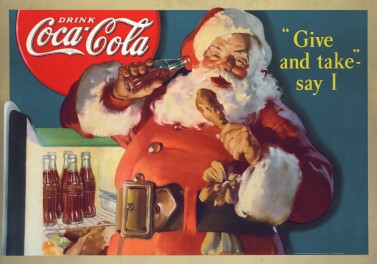 Commercialism might, in fact, be helping to bring the ambivalent, the agnostic, the indifferent, the conflicted… toward a festival of light in the darkness, toward a story of a birth unexplained that will change the world − whether we like it or not − toward an undeserved gift. We often are told that Christmas is about giving, but I wonder if – in the end – Christmas is really about receiving, and receiving more than we know we deserve. Can we accept the truth behind a story whose facts seem so outlandish, yet which has has inspired and irritated millions over the last couple of millennia? Can we embrace the various traditions of paganism and the many cultural variations of music and ritual and visitations by the Christmas Krampus as part of our own Christmas story? Can we grow to appreciate the countless small sacrifices of time and energy that our coaches and teachers and especially our parents have made, are making, and will continue to make to give us opportunity to put our own little ding in the universe? Can we receive the commercialization as a fact of our historical moment, but neither the foundation nor the fulfillment of this ancient celebration of life renewed and bonds restored? Can we remember that though Charlie Brown’s Christmas tree appeared short & scrawny at first sight, it was alive and therefore more full of hope and more beautiful than all the aluminum trees in the lot?
Commercialism might, in fact, be helping to bring the ambivalent, the agnostic, the indifferent, the conflicted… toward a festival of light in the darkness, toward a story of a birth unexplained that will change the world − whether we like it or not − toward an undeserved gift. We often are told that Christmas is about giving, but I wonder if – in the end – Christmas is really about receiving, and receiving more than we know we deserve. Can we accept the truth behind a story whose facts seem so outlandish, yet which has has inspired and irritated millions over the last couple of millennia? Can we embrace the various traditions of paganism and the many cultural variations of music and ritual and visitations by the Christmas Krampus as part of our own Christmas story? Can we grow to appreciate the countless small sacrifices of time and energy that our coaches and teachers and especially our parents have made, are making, and will continue to make to give us opportunity to put our own little ding in the universe? Can we receive the commercialization as a fact of our historical moment, but neither the foundation nor the fulfillment of this ancient celebration of life renewed and bonds restored? Can we remember that though Charlie Brown’s Christmas tree appeared short & scrawny at first sight, it was alive and therefore more full of hope and more beautiful than all the aluminum trees in the lot?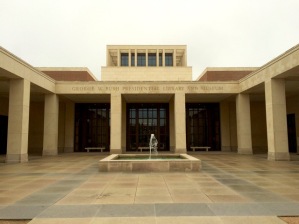
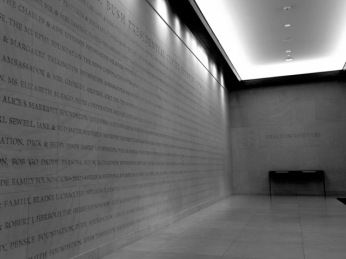 The building is austere, geometric, rather cold − odd traits given what even his political adversaries described as an affable, clubby, good-ole-boy. The interior is colder still. One enters to the right, along the Freedom Registry. The registry itself is to one’s right upon entering, and the table, the only organic object in the wing, invites the visitor by suggesting she or he can sign her or his name into the record book. Be a part of freedom! But no, if you’re visiting during regular hours with the hoi poloi , you clearly don’t have the capital gains income to be worthy of the Freedom Registry. Move along, please.
The building is austere, geometric, rather cold − odd traits given what even his political adversaries described as an affable, clubby, good-ole-boy. The interior is colder still. One enters to the right, along the Freedom Registry. The registry itself is to one’s right upon entering, and the table, the only organic object in the wing, invites the visitor by suggesting she or he can sign her or his name into the record book. Be a part of freedom! But no, if you’re visiting during regular hours with the hoi poloi , you clearly don’t have the capital gains income to be worthy of the Freedom Registry. Move along, please.
